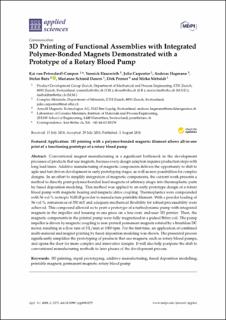Please use this identifier to cite or link to this item:
https://doi.org/10.21256/zhaw-4693Full metadata record
| DC Field | Value | Language |
|---|---|---|
| dc.contributor.author | von Petersdorff-Campen, Kai | - |
| dc.contributor.author | Hauswirth, Yannick | - |
| dc.contributor.author | Carpenter, Julia | - |
| dc.contributor.author | Hagmann, Andreas | - |
| dc.contributor.author | Boës, Stefan | - |
| dc.contributor.author | Schmid Daners, Marianne | - |
| dc.contributor.author | Penner, Dirk | - |
| dc.contributor.author | Meboldt, Mirko | - |
| dc.date.accessioned | 2018-08-17T13:10:06Z | - |
| dc.date.available | 2018-08-17T13:10:06Z | - |
| dc.date.issued | 2018-08 | - |
| dc.identifier.issn | 2076-3417 | de_CH |
| dc.identifier.uri | https://digitalcollection.zhaw.ch/handle/11475/9212 | - |
| dc.description.abstract | Conventional magnet manufacturing is a significant bottleneck in the development processes of products that use magnets, because every design adaption requires production steps with long lead times. Additive manufacturing of magnetic components delivers the opportunity to shift to agile and test-driven development in early prototyping stages, as well as new possibilities for complex designs. In an effort to simplify integration of magnetic components, the current work presents a method to directly print polymer-bonded hard magnets of arbitrary shape into thermoplastic parts by fused deposition modeling. This method was applied to an early prototype design of a rotary blood pump with magnetic bearing and magnetic drive coupling. Thermoplastics were compounded with 56 vol.% isotropic NdFeB powder to manufacture printable filament. With a powder loading of 56 vol.%, remanences of 350 mT and adequate mechanical flexibility for robust processability were achieved. This compound allowed us to print a prototype of a turbodynamic pump with integrated magnets in the impeller and housing in one piece on a low-cost, end-user 3D printer. Then, the magnetic components in the printed pump were fully magnetized in a pulsed Bitter coil. The pump impeller is driven by magnetic coupling to non-printed permanent magnets rotated by a brushless DC motor, resulting in a flow rate of 3 L/min at 1000 rpm. For the first time, an application of combined multi-material and magnet printing by fused deposition modeling was shown. The presented process significantly simplifies the prototyping of products that use magnets, such as rotary blood pumps, and opens the door for more complex and innovative designs. It will also help postpone the shift to conventional manufacturing methods to later phases of the development process. | de_CH |
| dc.language.iso | en | de_CH |
| dc.publisher | MDPI | de_CH |
| dc.relation.ispartof | Applied Sciences | de_CH |
| dc.rights | https://creativecommons.org/licenses/by/4.0/ | de_CH |
| dc.subject.ddc | 670: Industrielle und handwerkliche Fertigung | de_CH |
| dc.title | 3D printing of functional assemblies with integrated polymer-bonded magnets demonstrated with a prototype of a rotary blood pump | de_CH |
| dc.type | Beitrag in wissenschaftlicher Zeitschrift | de_CH |
| dcterms.type | Text | de_CH |
| zhaw.departement | School of Engineering | de_CH |
| zhaw.organisationalunit | Institute of Materials and Process Engineering (IMPE) | de_CH |
| dc.identifier.doi | 10.3390/app8081275 | de_CH |
| dc.identifier.doi | 10.21256/zhaw-4693 | - |
| zhaw.funding.eu | No | de_CH |
| zhaw.issue | 8 | de_CH |
| zhaw.originated.zhaw | Yes | de_CH |
| zhaw.pages.start | 1275 | de_CH |
| zhaw.publication.status | publishedVersion | de_CH |
| zhaw.volume | 8 | de_CH |
| zhaw.publication.review | Peer review (Publikation) | de_CH |
| zhaw.webfeed | Keramische Materialien | de_CH |
| zhaw.webfeed | Additive Manufacturing | de_CH |
| Appears in collections: | Publikationen School of Engineering | |
Files in This Item:
| File | Description | Size | Format | |
|---|---|---|---|---|
| 2018_Petersdorff-Campen_3D_printing_of_functional_assemblies.pdf | 1.32 MB | Adobe PDF |  View/Open |
Show simple item record
von Petersdorff-Campen, K., Hauswirth, Y., Carpenter, J., Hagmann, A., Boës, S., Schmid Daners, M., Penner, D., & Meboldt, M. (2018). 3D printing of functional assemblies with integrated polymer-bonded magnets demonstrated with a prototype of a rotary blood pump. Applied Sciences, 8(8), 1275. https://doi.org/10.3390/app8081275
von Petersdorff-Campen, K. et al. (2018) ‘3D printing of functional assemblies with integrated polymer-bonded magnets demonstrated with a prototype of a rotary blood pump’, Applied Sciences, 8(8), p. 1275. Available at: https://doi.org/10.3390/app8081275.
K. von Petersdorff-Campen et al., “3D printing of functional assemblies with integrated polymer-bonded magnets demonstrated with a prototype of a rotary blood pump,” Applied Sciences, vol. 8, no. 8, p. 1275, Aug. 2018, doi: 10.3390/app8081275.
VON PETERSDORFF-CAMPEN, Kai, Yannick HAUSWIRTH, Julia CARPENTER, Andreas HAGMANN, Stefan BOËS, Marianne SCHMID DANERS, Dirk PENNER und Mirko MEBOLDT, 2018. 3D printing of functional assemblies with integrated polymer-bonded magnets demonstrated with a prototype of a rotary blood pump. Applied Sciences. August 2018. Bd. 8, Nr. 8, S. 1275. DOI 10.3390/app8081275
von Petersdorff-Campen, Kai, Yannick Hauswirth, Julia Carpenter, Andreas Hagmann, Stefan Boës, Marianne Schmid Daners, Dirk Penner, and Mirko Meboldt. 2018. “3D Printing of Functional Assemblies with Integrated Polymer-Bonded Magnets Demonstrated with a Prototype of a Rotary Blood Pump.” Applied Sciences 8 (8): 1275. https://doi.org/10.3390/app8081275.
von Petersdorff-Campen, Kai, et al. “3D Printing of Functional Assemblies with Integrated Polymer-Bonded Magnets Demonstrated with a Prototype of a Rotary Blood Pump.” Applied Sciences, vol. 8, no. 8, Aug. 2018, p. 1275, https://doi.org/10.3390/app8081275.
Items in DSpace are protected by copyright, with all rights reserved, unless otherwise indicated.